Final Project Report: Self-Healing Concrete by Bacteria Approach
VerifiedAdded on 2022/10/17
|39
|9257
|11
Report
AI Summary
This report provides a comprehensive analysis of self-healing concrete, specifically focusing on the bacterial approach to crack remediation. It begins with an abstract and executive summary, followed by an introduction that highlights the significance of self-healing concrete and the environmental benefits of using bacteria. A detailed literature review explores the grouping of bacteria, with a specific focus on the types used for self-healing concrete, their concentrations, and the influence of nutrient types. The methodology section outlines the choice and cultivation of alkali-resistant, spore-forming bacteria, the preparation and strength features of bacterial concrete, and the assessment of calcite precipitation ability. The analysis section presents findings on the strength features, viability of spores, and calcite precipitation. The discussion section interprets the results and compares them with existing literature. The report concludes with a summary of the findings, recommendations for future research, and a list of references.
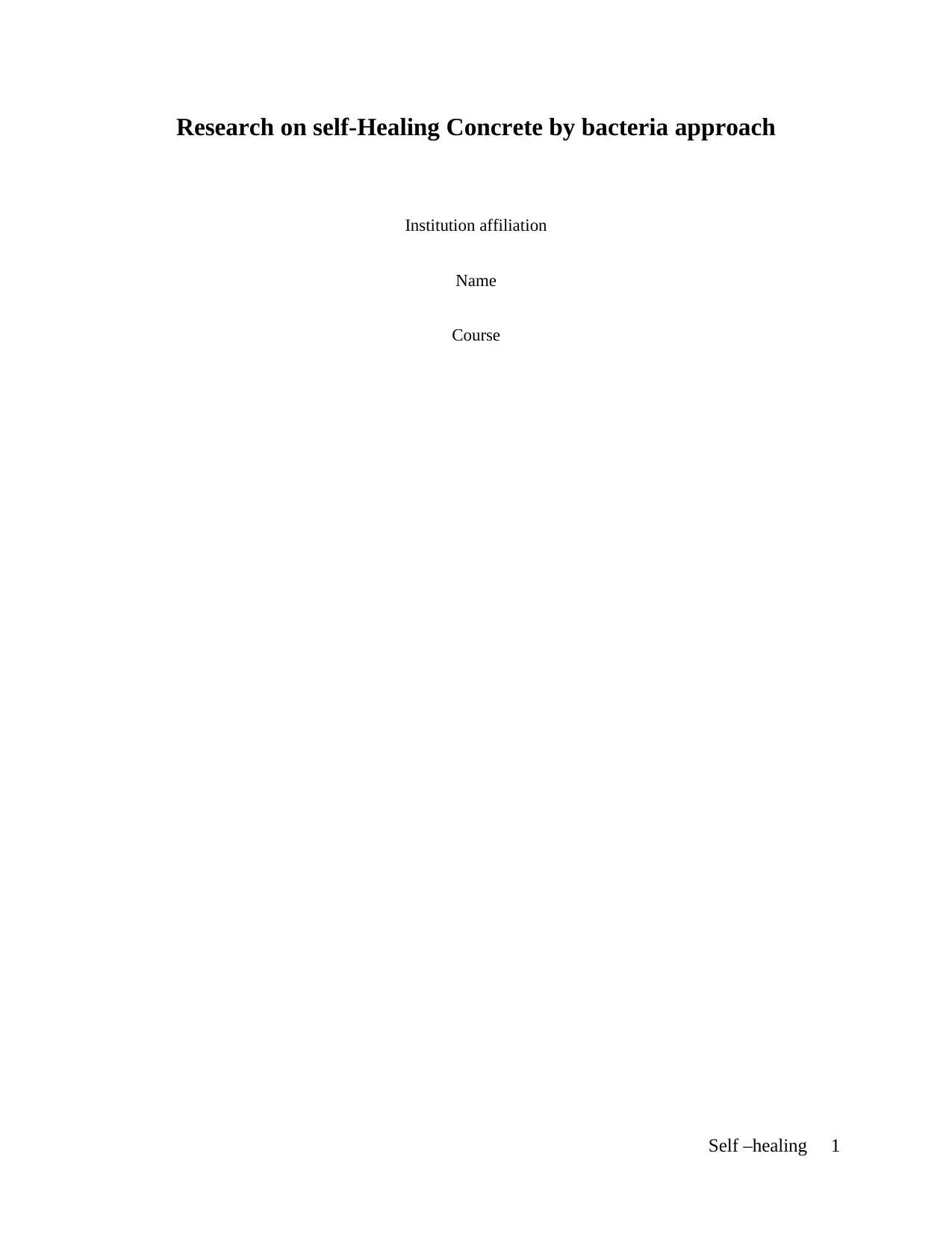
Research on self-Healing Concrete by bacteria approach
Institution affiliation
Name
Course
Self –healing 1
Institution affiliation
Name
Course
Self –healing 1
Paraphrase This Document
Need a fresh take? Get an instant paraphrase of this document with our AI Paraphraser
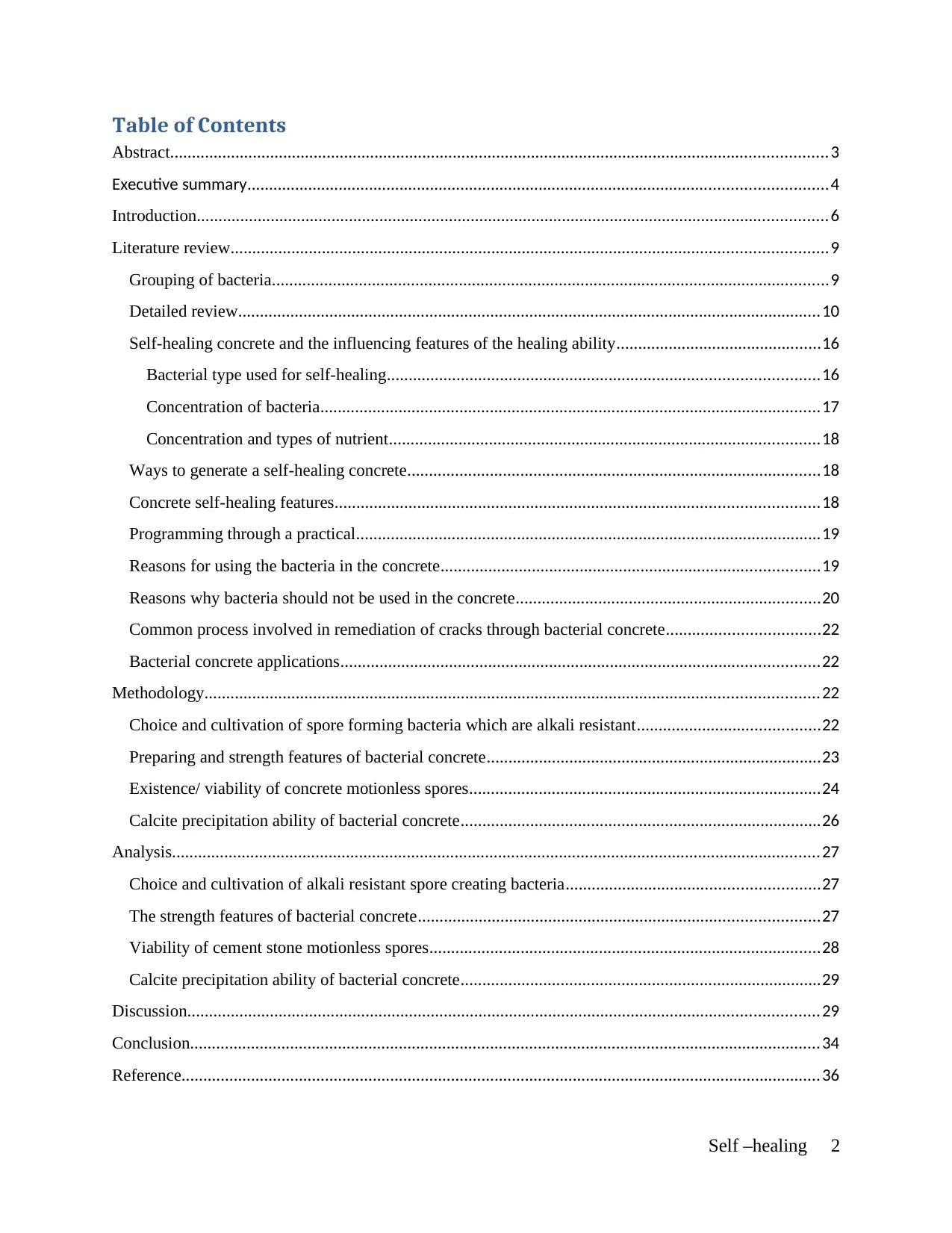
Table of Contents
Abstract.......................................................................................................................................................3
Executive summary.....................................................................................................................................4
Introduction.................................................................................................................................................6
Literature review.........................................................................................................................................9
Grouping of bacteria................................................................................................................................9
Detailed review......................................................................................................................................10
Self-healing concrete and the influencing features of the healing ability...............................................16
Bacterial type used for self-healing...................................................................................................16
Concentration of bacteria...................................................................................................................17
Concentration and types of nutrient...................................................................................................18
Ways to generate a self-healing concrete...............................................................................................18
Concrete self-healing features...............................................................................................................18
Programming through a practical...........................................................................................................19
Reasons for using the bacteria in the concrete.......................................................................................19
Reasons why bacteria should not be used in the concrete......................................................................20
Common process involved in remediation of cracks through bacterial concrete...................................22
Bacterial concrete applications..............................................................................................................22
Methodology.............................................................................................................................................22
Choice and cultivation of spore forming bacteria which are alkali resistant..........................................22
Preparing and strength features of bacterial concrete.............................................................................23
Existence/ viability of concrete motionless spores.................................................................................24
Calcite precipitation ability of bacterial concrete...................................................................................26
Analysis.....................................................................................................................................................27
Choice and cultivation of alkali resistant spore creating bacteria..........................................................27
The strength features of bacterial concrete............................................................................................27
Viability of cement stone motionless spores..........................................................................................28
Calcite precipitation ability of bacterial concrete...................................................................................29
Discussion.................................................................................................................................................29
Conclusion.................................................................................................................................................34
Reference...................................................................................................................................................36
Self –healing 2
Abstract.......................................................................................................................................................3
Executive summary.....................................................................................................................................4
Introduction.................................................................................................................................................6
Literature review.........................................................................................................................................9
Grouping of bacteria................................................................................................................................9
Detailed review......................................................................................................................................10
Self-healing concrete and the influencing features of the healing ability...............................................16
Bacterial type used for self-healing...................................................................................................16
Concentration of bacteria...................................................................................................................17
Concentration and types of nutrient...................................................................................................18
Ways to generate a self-healing concrete...............................................................................................18
Concrete self-healing features...............................................................................................................18
Programming through a practical...........................................................................................................19
Reasons for using the bacteria in the concrete.......................................................................................19
Reasons why bacteria should not be used in the concrete......................................................................20
Common process involved in remediation of cracks through bacterial concrete...................................22
Bacterial concrete applications..............................................................................................................22
Methodology.............................................................................................................................................22
Choice and cultivation of spore forming bacteria which are alkali resistant..........................................22
Preparing and strength features of bacterial concrete.............................................................................23
Existence/ viability of concrete motionless spores.................................................................................24
Calcite precipitation ability of bacterial concrete...................................................................................26
Analysis.....................................................................................................................................................27
Choice and cultivation of alkali resistant spore creating bacteria..........................................................27
The strength features of bacterial concrete............................................................................................27
Viability of cement stone motionless spores..........................................................................................28
Calcite precipitation ability of bacterial concrete...................................................................................29
Discussion.................................................................................................................................................29
Conclusion.................................................................................................................................................34
Reference...................................................................................................................................................36
Self –healing 2
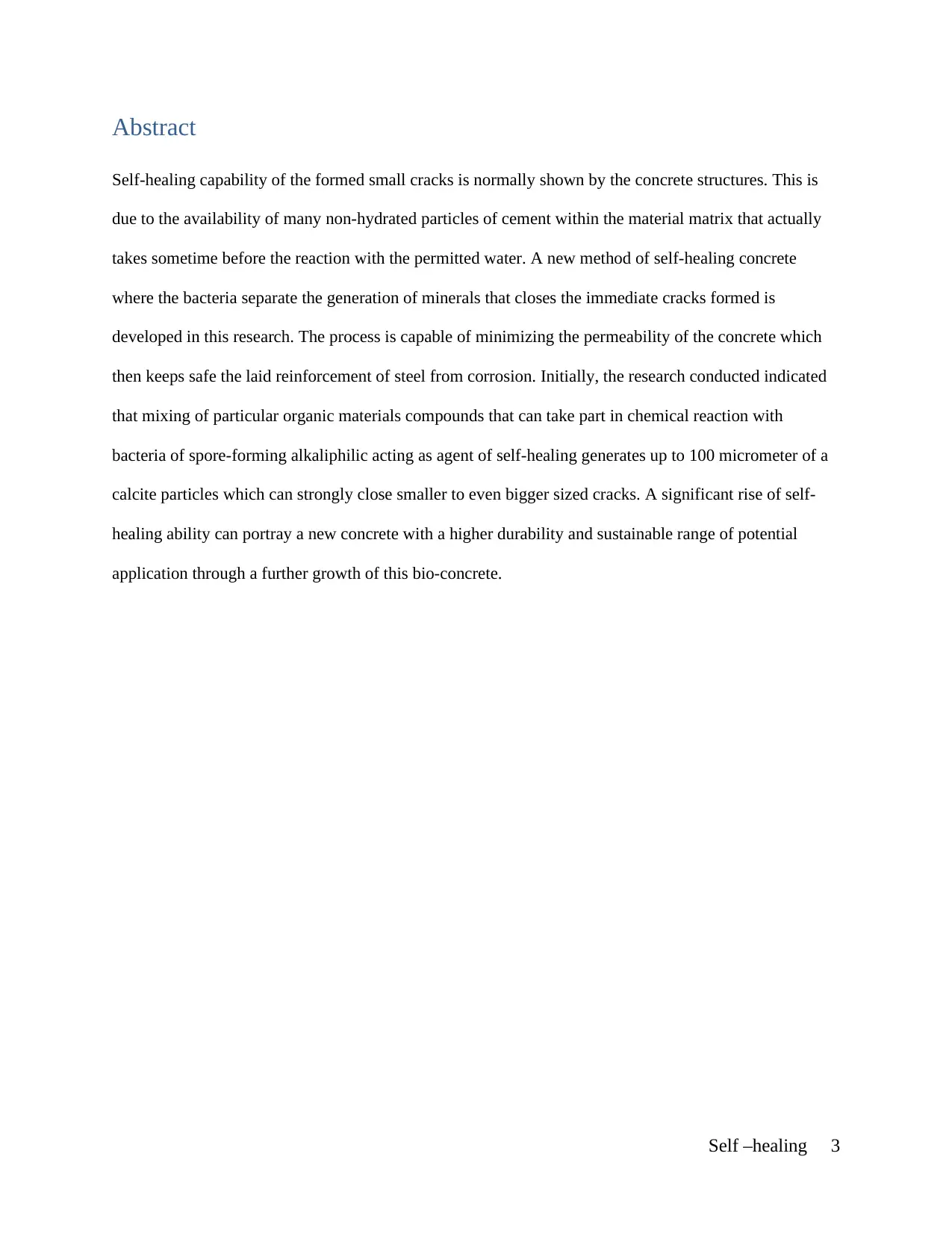
Abstract
Self-healing capability of the formed small cracks is normally shown by the concrete structures. This is
due to the availability of many non-hydrated particles of cement within the material matrix that actually
takes sometime before the reaction with the permitted water. A new method of self-healing concrete
where the bacteria separate the generation of minerals that closes the immediate cracks formed is
developed in this research. The process is capable of minimizing the permeability of the concrete which
then keeps safe the laid reinforcement of steel from corrosion. Initially, the research conducted indicated
that mixing of particular organic materials compounds that can take part in chemical reaction with
bacteria of spore-forming alkaliphilic acting as agent of self-healing generates up to 100 micrometer of a
calcite particles which can strongly close smaller to even bigger sized cracks. A significant rise of self-
healing ability can portray a new concrete with a higher durability and sustainable range of potential
application through a further growth of this bio-concrete.
Self –healing 3
Self-healing capability of the formed small cracks is normally shown by the concrete structures. This is
due to the availability of many non-hydrated particles of cement within the material matrix that actually
takes sometime before the reaction with the permitted water. A new method of self-healing concrete
where the bacteria separate the generation of minerals that closes the immediate cracks formed is
developed in this research. The process is capable of minimizing the permeability of the concrete which
then keeps safe the laid reinforcement of steel from corrosion. Initially, the research conducted indicated
that mixing of particular organic materials compounds that can take part in chemical reaction with
bacteria of spore-forming alkaliphilic acting as agent of self-healing generates up to 100 micrometer of a
calcite particles which can strongly close smaller to even bigger sized cracks. A significant rise of self-
healing ability can portray a new concrete with a higher durability and sustainable range of potential
application through a further growth of this bio-concrete.
Self –healing 3
⊘ This is a preview!⊘
Do you want full access?
Subscribe today to unlock all pages.

Trusted by 1+ million students worldwide
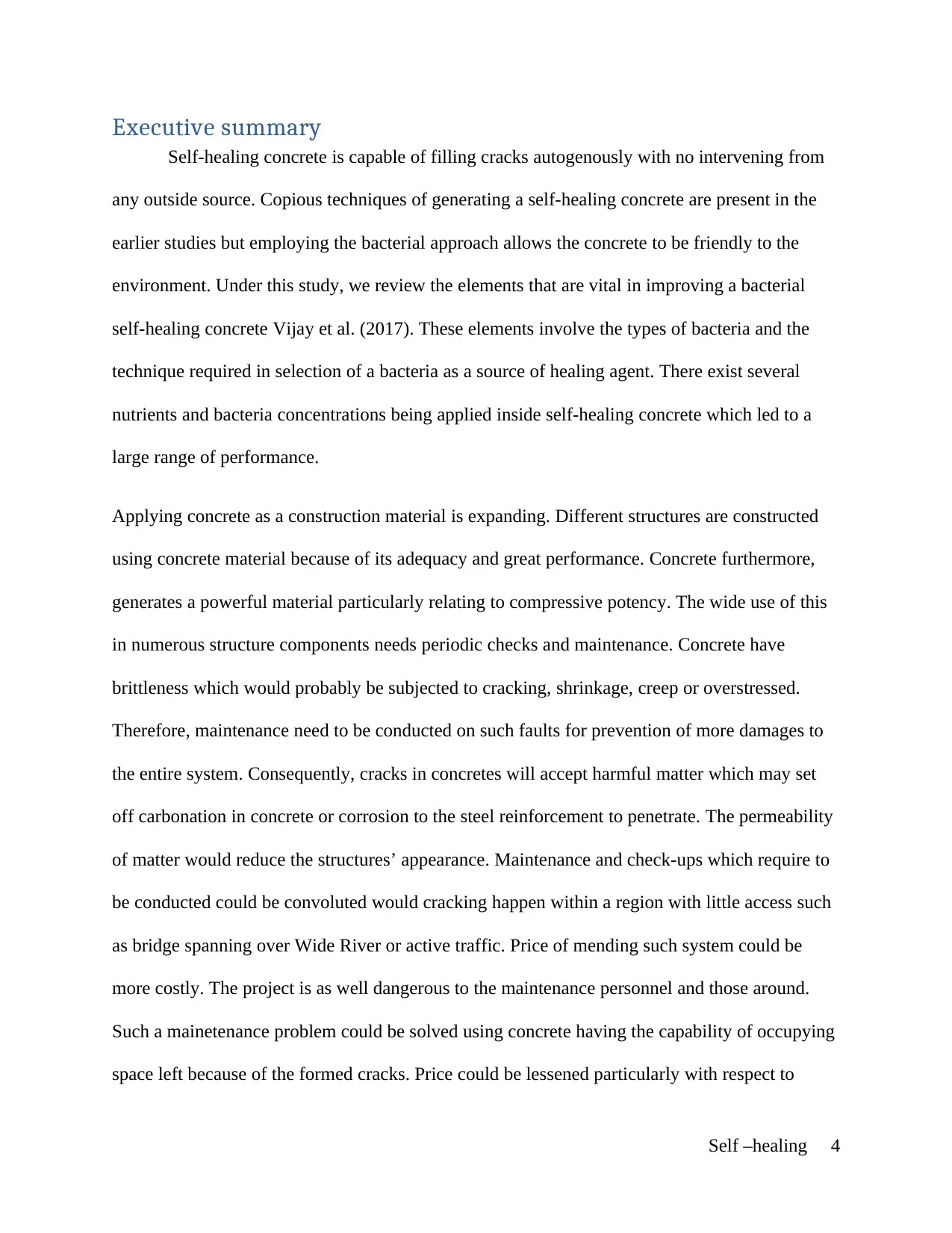
Executive summary
Self-healing concrete is capable of filling cracks autogenously with no intervening from
any outside source. Copious techniques of generating a self-healing concrete are present in the
earlier studies but employing the bacterial approach allows the concrete to be friendly to the
environment. Under this study, we review the elements that are vital in improving a bacterial
self-healing concrete Vijay et al. (2017). These elements involve the types of bacteria and the
technique required in selection of a bacteria as a source of healing agent. There exist several
nutrients and bacteria concentrations being applied inside self-healing concrete which led to a
large range of performance.
Applying concrete as a construction material is expanding. Different structures are constructed
using concrete material because of its adequacy and great performance. Concrete furthermore,
generates a powerful material particularly relating to compressive potency. The wide use of this
in numerous structure components needs periodic checks and maintenance. Concrete have
brittleness which would probably be subjected to cracking, shrinkage, creep or overstressed.
Therefore, maintenance need to be conducted on such faults for prevention of more damages to
the entire system. Consequently, cracks in concretes will accept harmful matter which may set
off carbonation in concrete or corrosion to the steel reinforcement to penetrate. The permeability
of matter would reduce the structures’ appearance. Maintenance and check-ups which require to
be conducted could be convoluted would cracking happen within a region with little access such
as bridge spanning over Wide River or active traffic. Price of mending such system could be
more costly. The project is as well dangerous to the maintenance personnel and those around.
Such a mainetenance problem could be solved using concrete having the capability of occupying
space left because of the formed cracks. Price could be lessened particularly with respect to
Self –healing 4
Self-healing concrete is capable of filling cracks autogenously with no intervening from
any outside source. Copious techniques of generating a self-healing concrete are present in the
earlier studies but employing the bacterial approach allows the concrete to be friendly to the
environment. Under this study, we review the elements that are vital in improving a bacterial
self-healing concrete Vijay et al. (2017). These elements involve the types of bacteria and the
technique required in selection of a bacteria as a source of healing agent. There exist several
nutrients and bacteria concentrations being applied inside self-healing concrete which led to a
large range of performance.
Applying concrete as a construction material is expanding. Different structures are constructed
using concrete material because of its adequacy and great performance. Concrete furthermore,
generates a powerful material particularly relating to compressive potency. The wide use of this
in numerous structure components needs periodic checks and maintenance. Concrete have
brittleness which would probably be subjected to cracking, shrinkage, creep or overstressed.
Therefore, maintenance need to be conducted on such faults for prevention of more damages to
the entire system. Consequently, cracks in concretes will accept harmful matter which may set
off carbonation in concrete or corrosion to the steel reinforcement to penetrate. The permeability
of matter would reduce the structures’ appearance. Maintenance and check-ups which require to
be conducted could be convoluted would cracking happen within a region with little access such
as bridge spanning over Wide River or active traffic. Price of mending such system could be
more costly. The project is as well dangerous to the maintenance personnel and those around.
Such a mainetenance problem could be solved using concrete having the capability of occupying
space left because of the formed cracks. Price could be lessened particularly with respect to
Self –healing 4
Paraphrase This Document
Need a fresh take? Get an instant paraphrase of this document with our AI Paraphraser
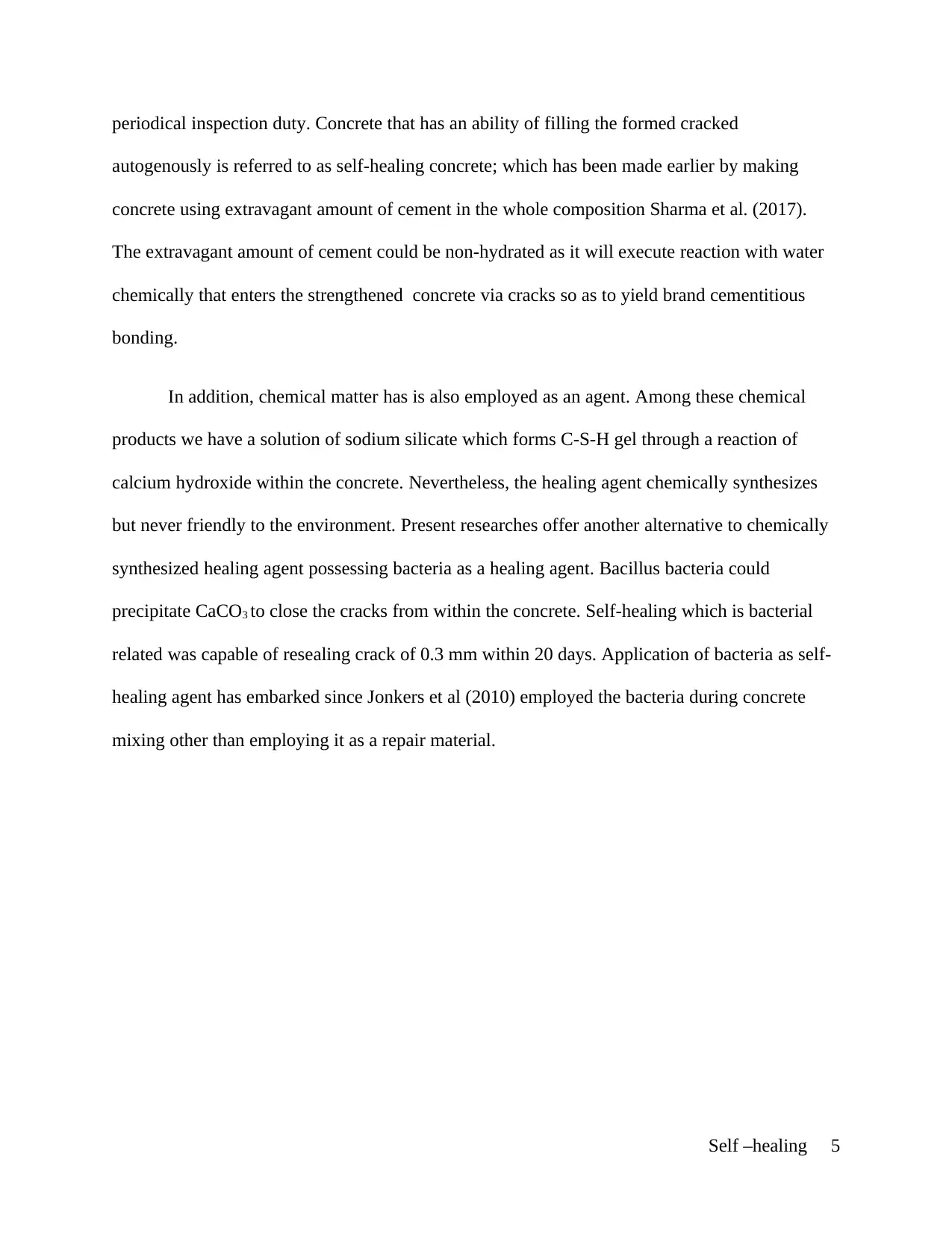
periodical inspection duty. Concrete that has an ability of filling the formed cracked
autogenously is referred to as self-healing concrete; which has been made earlier by making
concrete using extravagant amount of cement in the whole composition Sharma et al. (2017).
The extravagant amount of cement could be non-hydrated as it will execute reaction with water
chemically that enters the strengthened concrete via cracks so as to yield brand cementitious
bonding.
In addition, chemical matter has is also employed as an agent. Among these chemical
products we have a solution of sodium silicate which forms C-S-H gel through a reaction of
calcium hydroxide within the concrete. Nevertheless, the healing agent chemically synthesizes
but never friendly to the environment. Present researches offer another alternative to chemically
synthesized healing agent possessing bacteria as a healing agent. Bacillus bacteria could
precipitate CaCO3 to close the cracks from within the concrete. Self-healing which is bacterial
related was capable of resealing crack of 0.3 mm within 20 days. Application of bacteria as self-
healing agent has embarked since Jonkers et al (2010) employed the bacteria during concrete
mixing other than employing it as a repair material.
Self –healing 5
autogenously is referred to as self-healing concrete; which has been made earlier by making
concrete using extravagant amount of cement in the whole composition Sharma et al. (2017).
The extravagant amount of cement could be non-hydrated as it will execute reaction with water
chemically that enters the strengthened concrete via cracks so as to yield brand cementitious
bonding.
In addition, chemical matter has is also employed as an agent. Among these chemical
products we have a solution of sodium silicate which forms C-S-H gel through a reaction of
calcium hydroxide within the concrete. Nevertheless, the healing agent chemically synthesizes
but never friendly to the environment. Present researches offer another alternative to chemically
synthesized healing agent possessing bacteria as a healing agent. Bacillus bacteria could
precipitate CaCO3 to close the cracks from within the concrete. Self-healing which is bacterial
related was capable of resealing crack of 0.3 mm within 20 days. Application of bacteria as self-
healing agent has embarked since Jonkers et al (2010) employed the bacteria during concrete
mixing other than employing it as a repair material.
Self –healing 5
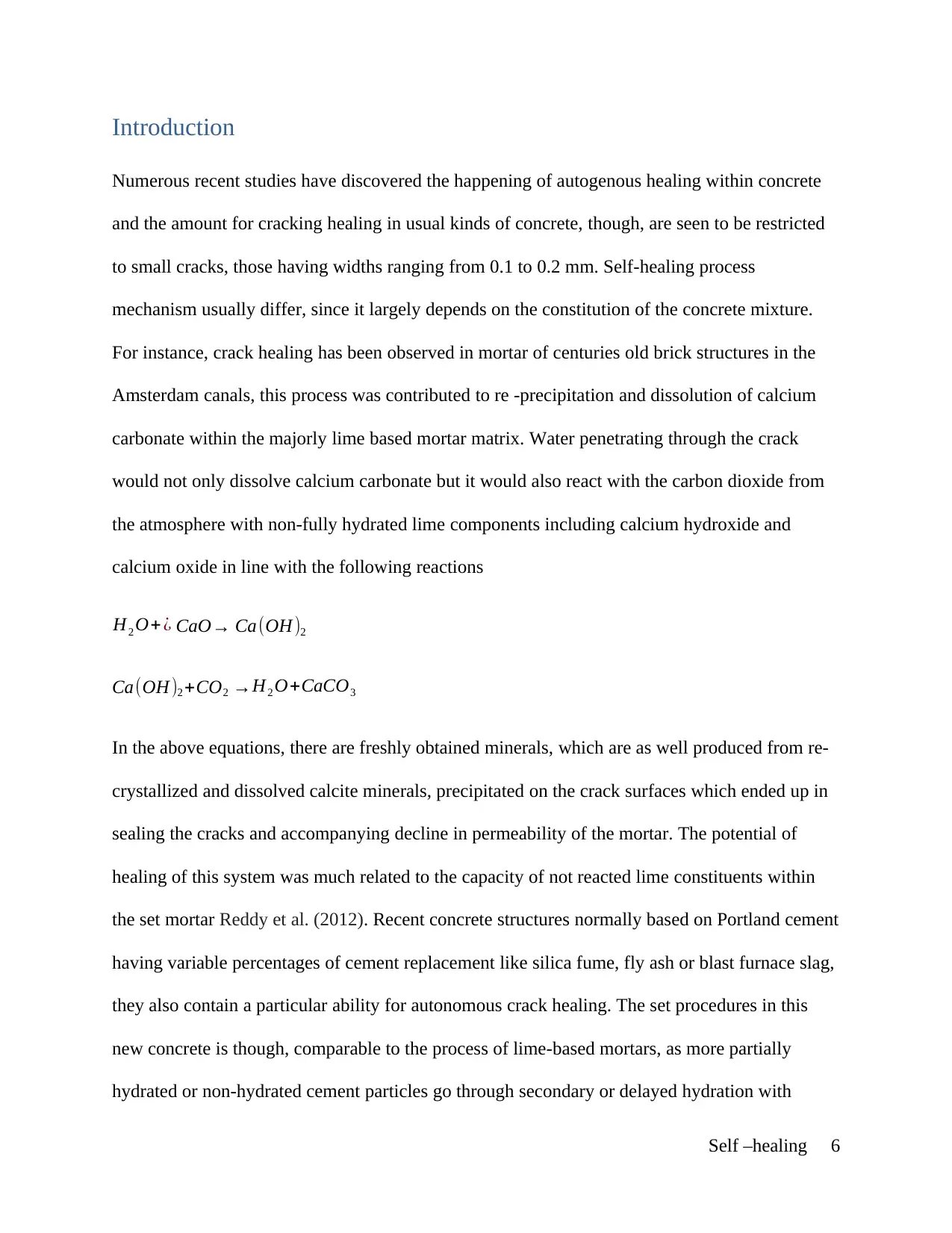
Introduction
Numerous recent studies have discovered the happening of autogenous healing within concrete
and the amount for cracking healing in usual kinds of concrete, though, are seen to be restricted
to small cracks, those having widths ranging from 0.1 to 0.2 mm. Self-healing process
mechanism usually differ, since it largely depends on the constitution of the concrete mixture.
For instance, crack healing has been observed in mortar of centuries old brick structures in the
Amsterdam canals, this process was contributed to re -precipitation and dissolution of calcium
carbonate within the majorly lime based mortar matrix. Water penetrating through the crack
would not only dissolve calcium carbonate but it would also react with the carbon dioxide from
the atmosphere with non-fully hydrated lime components including calcium hydroxide and
calcium oxide in line with the following reactions
H2 O+ ¿ CaO→ Ca(OH )2
Ca(OH )2 +CO2 → H2 O+CaCO3
In the above equations, there are freshly obtained minerals, which are as well produced from re-
crystallized and dissolved calcite minerals, precipitated on the crack surfaces which ended up in
sealing the cracks and accompanying decline in permeability of the mortar. The potential of
healing of this system was much related to the capacity of not reacted lime constituents within
the set mortar Reddy et al. (2012). Recent concrete structures normally based on Portland cement
having variable percentages of cement replacement like silica fume, fly ash or blast furnace slag,
they also contain a particular ability for autonomous crack healing. The set procedures in this
new concrete is though, comparable to the process of lime-based mortars, as more partially
hydrated or non-hydrated cement particles go through secondary or delayed hydration with
Self –healing 6
Numerous recent studies have discovered the happening of autogenous healing within concrete
and the amount for cracking healing in usual kinds of concrete, though, are seen to be restricted
to small cracks, those having widths ranging from 0.1 to 0.2 mm. Self-healing process
mechanism usually differ, since it largely depends on the constitution of the concrete mixture.
For instance, crack healing has been observed in mortar of centuries old brick structures in the
Amsterdam canals, this process was contributed to re -precipitation and dissolution of calcium
carbonate within the majorly lime based mortar matrix. Water penetrating through the crack
would not only dissolve calcium carbonate but it would also react with the carbon dioxide from
the atmosphere with non-fully hydrated lime components including calcium hydroxide and
calcium oxide in line with the following reactions
H2 O+ ¿ CaO→ Ca(OH )2
Ca(OH )2 +CO2 → H2 O+CaCO3
In the above equations, there are freshly obtained minerals, which are as well produced from re-
crystallized and dissolved calcite minerals, precipitated on the crack surfaces which ended up in
sealing the cracks and accompanying decline in permeability of the mortar. The potential of
healing of this system was much related to the capacity of not reacted lime constituents within
the set mortar Reddy et al. (2012). Recent concrete structures normally based on Portland cement
having variable percentages of cement replacement like silica fume, fly ash or blast furnace slag,
they also contain a particular ability for autonomous crack healing. The set procedures in this
new concrete is though, comparable to the process of lime-based mortars, as more partially
hydrated or non-hydrated cement particles go through secondary or delayed hydration with
Self –healing 6
⊘ This is a preview!⊘
Do you want full access?
Subscribe today to unlock all pages.

Trusted by 1+ million students worldwide
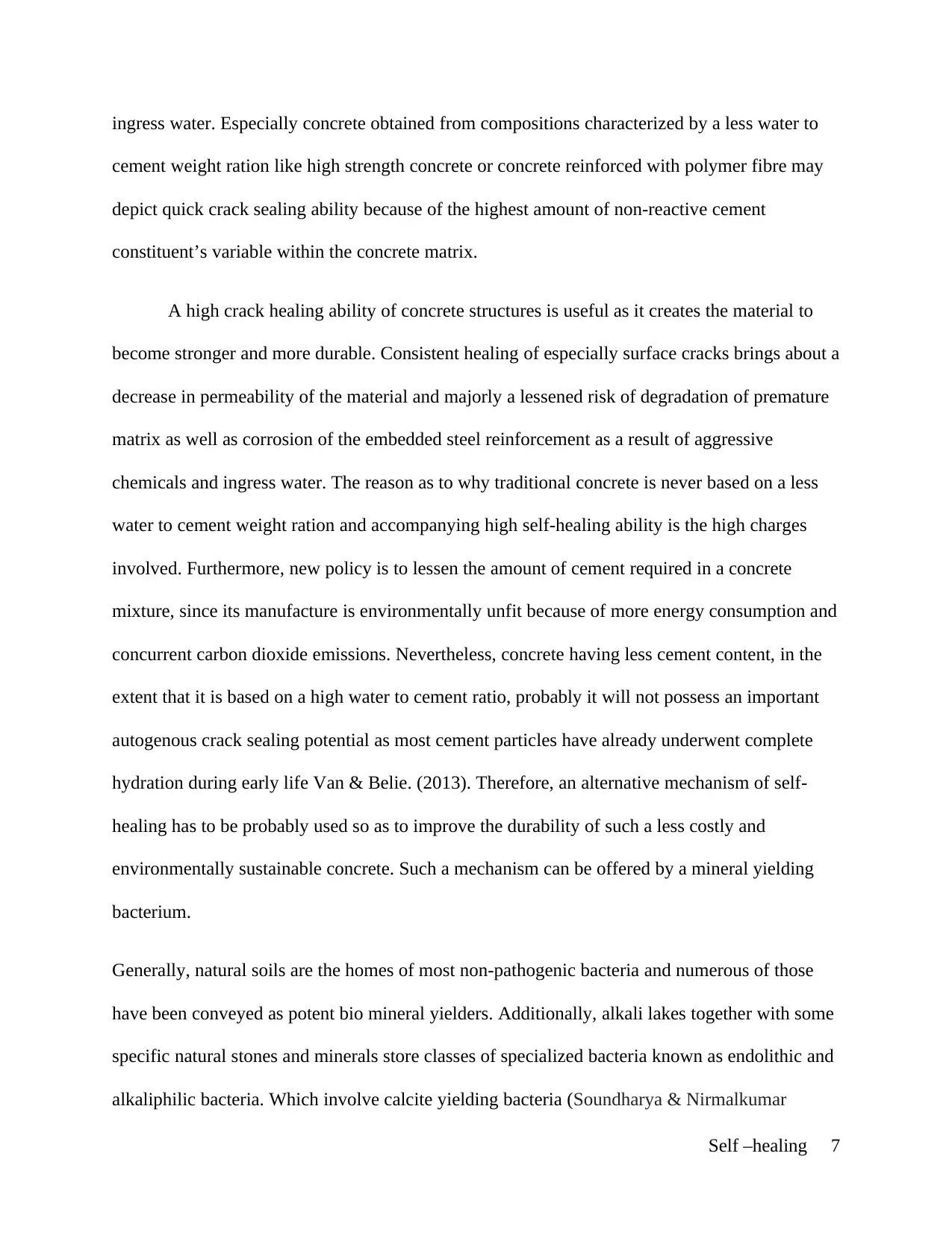
ingress water. Especially concrete obtained from compositions characterized by a less water to
cement weight ration like high strength concrete or concrete reinforced with polymer fibre may
depict quick crack sealing ability because of the highest amount of non-reactive cement
constituent’s variable within the concrete matrix.
A high crack healing ability of concrete structures is useful as it creates the material to
become stronger and more durable. Consistent healing of especially surface cracks brings about a
decrease in permeability of the material and majorly a lessened risk of degradation of premature
matrix as well as corrosion of the embedded steel reinforcement as a result of aggressive
chemicals and ingress water. The reason as to why traditional concrete is never based on a less
water to cement weight ration and accompanying high self-healing ability is the high charges
involved. Furthermore, new policy is to lessen the amount of cement required in a concrete
mixture, since its manufacture is environmentally unfit because of more energy consumption and
concurrent carbon dioxide emissions. Nevertheless, concrete having less cement content, in the
extent that it is based on a high water to cement ratio, probably it will not possess an important
autogenous crack sealing potential as most cement particles have already underwent complete
hydration during early life Van & Belie. (2013). Therefore, an alternative mechanism of self-
healing has to be probably used so as to improve the durability of such a less costly and
environmentally sustainable concrete. Such a mechanism can be offered by a mineral yielding
bacterium.
Generally, natural soils are the homes of most non-pathogenic bacteria and numerous of those
have been conveyed as potent bio mineral yielders. Additionally, alkali lakes together with some
specific natural stones and minerals store classes of specialized bacteria known as endolithic and
alkaliphilic bacteria. Which involve calcite yielding bacteria (Soundharya & Nirmalkumar
Self –healing 7
cement weight ration like high strength concrete or concrete reinforced with polymer fibre may
depict quick crack sealing ability because of the highest amount of non-reactive cement
constituent’s variable within the concrete matrix.
A high crack healing ability of concrete structures is useful as it creates the material to
become stronger and more durable. Consistent healing of especially surface cracks brings about a
decrease in permeability of the material and majorly a lessened risk of degradation of premature
matrix as well as corrosion of the embedded steel reinforcement as a result of aggressive
chemicals and ingress water. The reason as to why traditional concrete is never based on a less
water to cement weight ration and accompanying high self-healing ability is the high charges
involved. Furthermore, new policy is to lessen the amount of cement required in a concrete
mixture, since its manufacture is environmentally unfit because of more energy consumption and
concurrent carbon dioxide emissions. Nevertheless, concrete having less cement content, in the
extent that it is based on a high water to cement ratio, probably it will not possess an important
autogenous crack sealing potential as most cement particles have already underwent complete
hydration during early life Van & Belie. (2013). Therefore, an alternative mechanism of self-
healing has to be probably used so as to improve the durability of such a less costly and
environmentally sustainable concrete. Such a mechanism can be offered by a mineral yielding
bacterium.
Generally, natural soils are the homes of most non-pathogenic bacteria and numerous of those
have been conveyed as potent bio mineral yielders. Additionally, alkali lakes together with some
specific natural stones and minerals store classes of specialized bacteria known as endolithic and
alkaliphilic bacteria. Which involve calcite yielding bacteria (Soundharya & Nirmalkumar
Self –healing 7
Paraphrase This Document
Need a fresh take? Get an instant paraphrase of this document with our AI Paraphraser
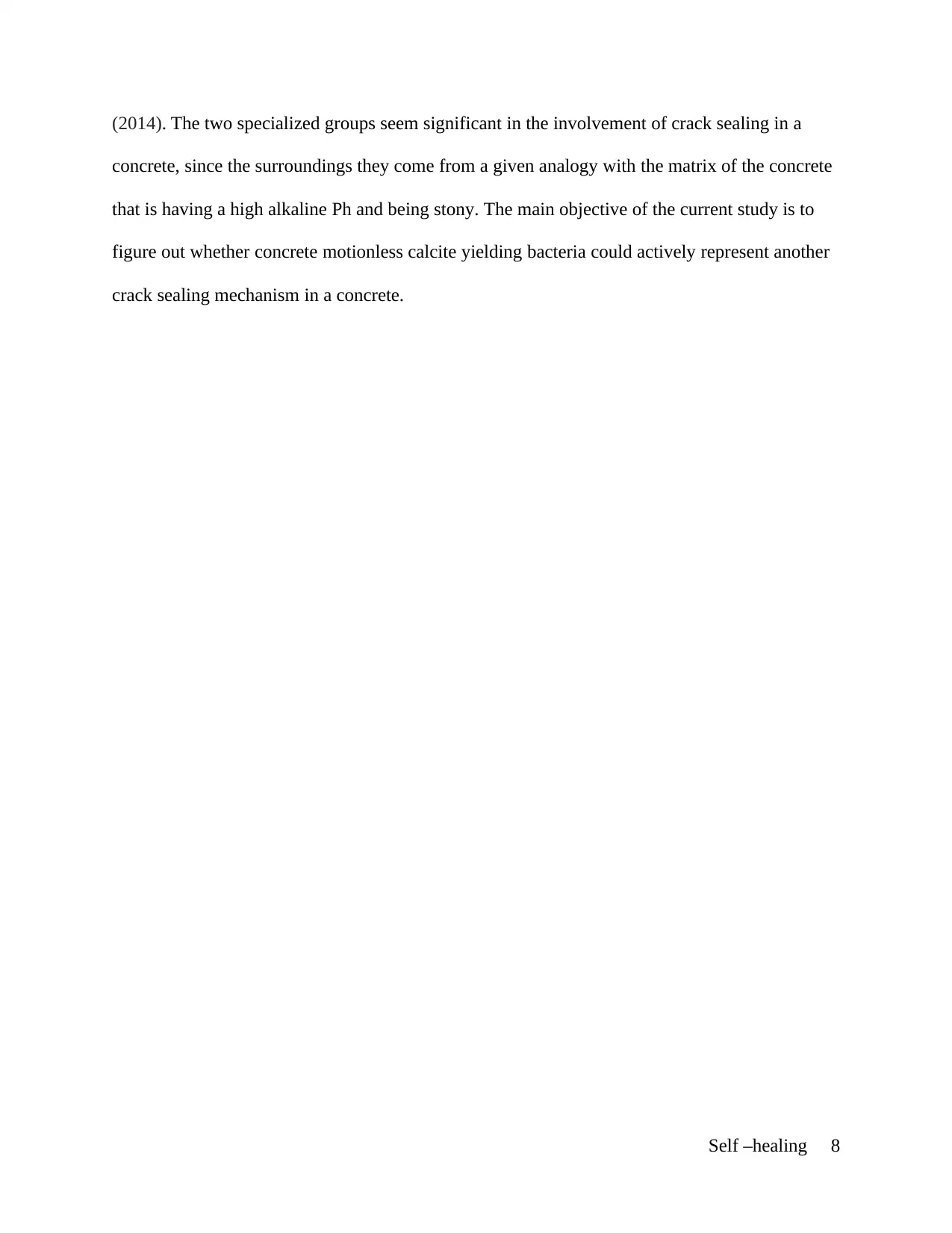
(2014). The two specialized groups seem significant in the involvement of crack sealing in a
concrete, since the surroundings they come from a given analogy with the matrix of the concrete
that is having a high alkaline Ph and being stony. The main objective of the current study is to
figure out whether concrete motionless calcite yielding bacteria could actively represent another
crack sealing mechanism in a concrete.
Self –healing 8
concrete, since the surroundings they come from a given analogy with the matrix of the concrete
that is having a high alkaline Ph and being stony. The main objective of the current study is to
figure out whether concrete motionless calcite yielding bacteria could actively represent another
crack sealing mechanism in a concrete.
Self –healing 8
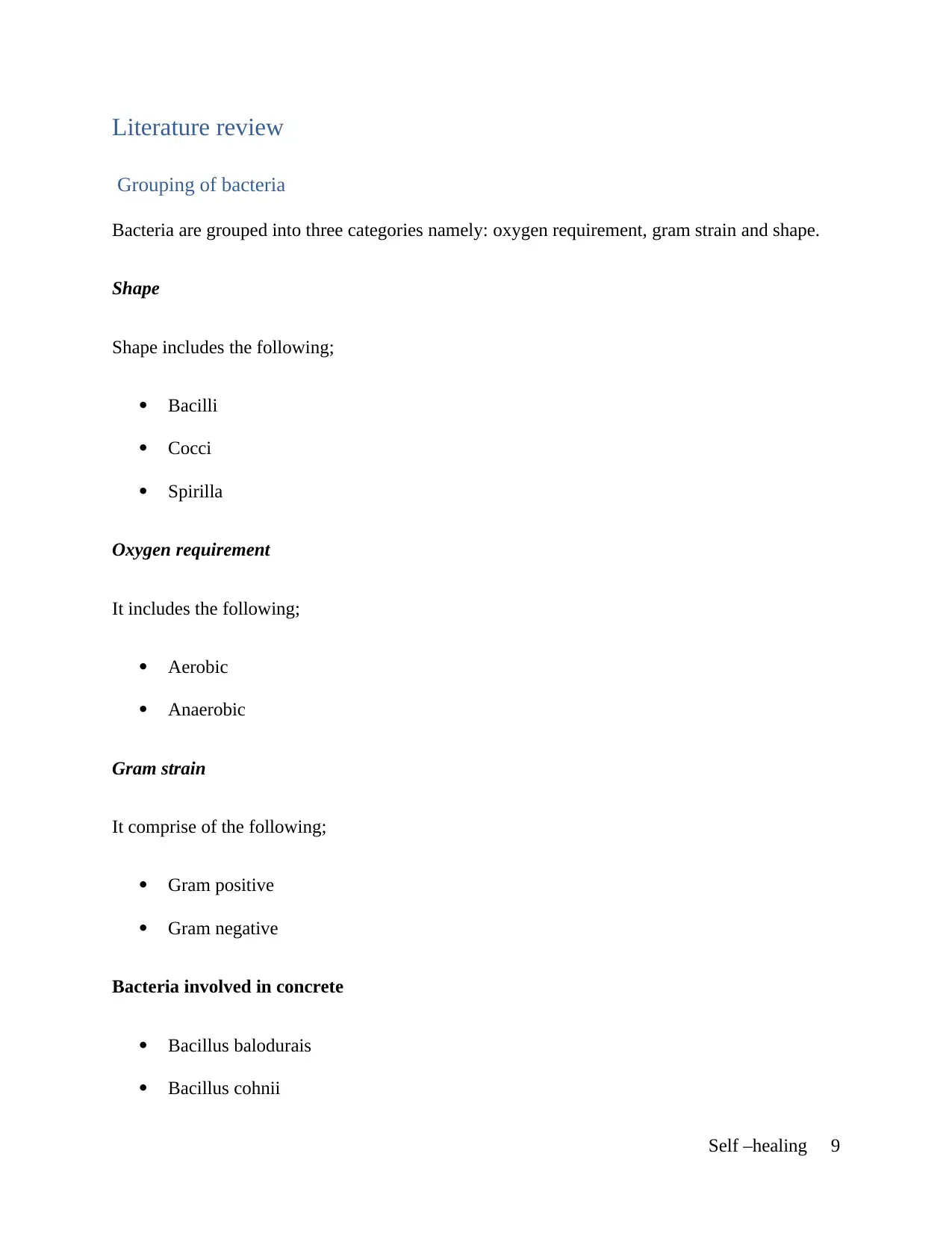
Literature review
Grouping of bacteria
Bacteria are grouped into three categories namely: oxygen requirement, gram strain and shape.
Shape
Shape includes the following;
Bacilli
Cocci
Spirilla
Oxygen requirement
It includes the following;
Aerobic
Anaerobic
Gram strain
It comprise of the following;
Gram positive
Gram negative
Bacteria involved in concrete
Bacillus balodurais
Bacillus cohnii
Self –healing 9
Grouping of bacteria
Bacteria are grouped into three categories namely: oxygen requirement, gram strain and shape.
Shape
Shape includes the following;
Bacilli
Cocci
Spirilla
Oxygen requirement
It includes the following;
Aerobic
Anaerobic
Gram strain
It comprise of the following;
Gram positive
Gram negative
Bacteria involved in concrete
Bacillus balodurais
Bacillus cohnii
Self –healing 9
⊘ This is a preview!⊘
Do you want full access?
Subscribe today to unlock all pages.

Trusted by 1+ million students worldwide
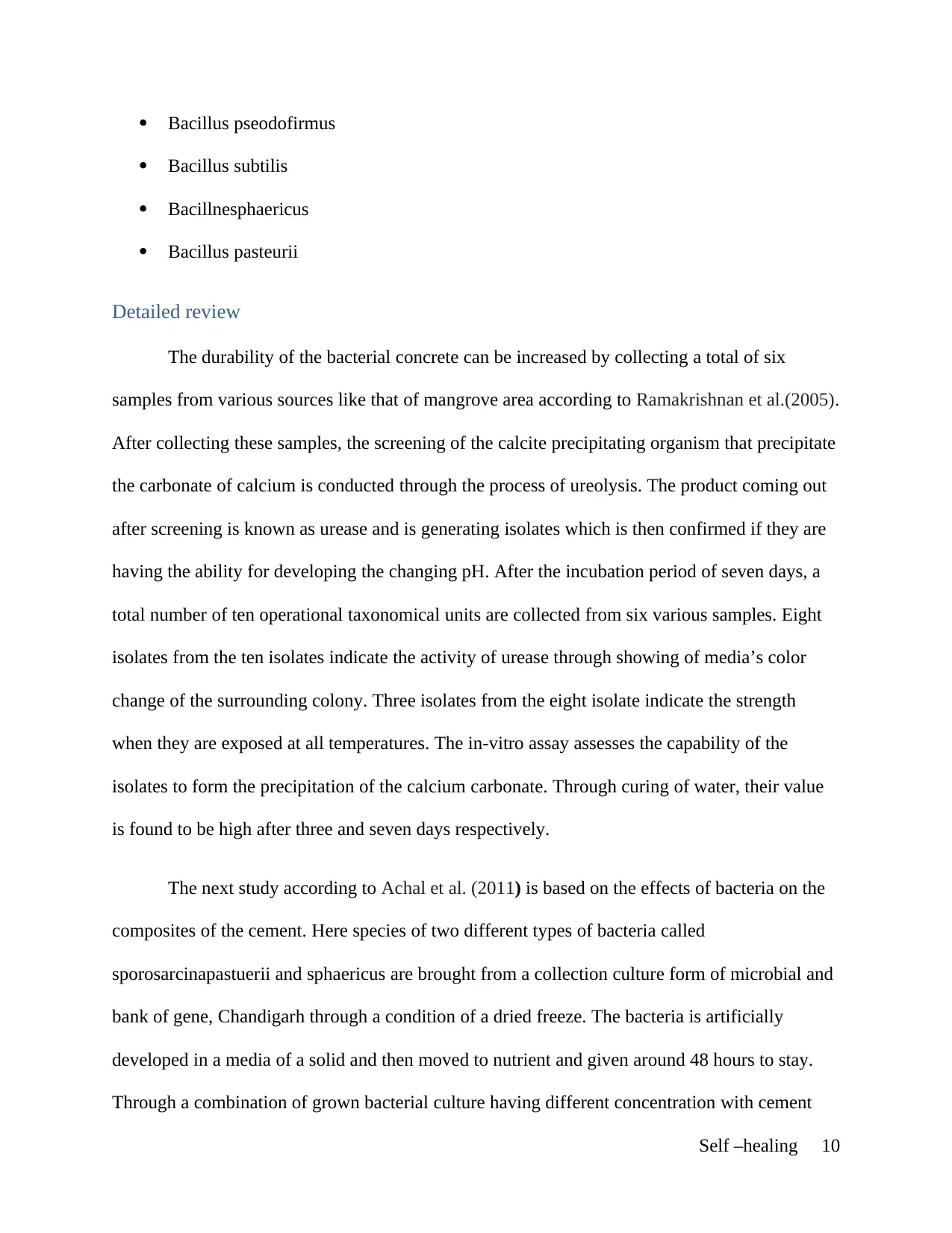
Bacillus pseodofirmus
Bacillus subtilis
Bacillnesphaericus
Bacillus pasteurii
Detailed review
The durability of the bacterial concrete can be increased by collecting a total of six
samples from various sources like that of mangrove area according to Ramakrishnan et al.(2005).
After collecting these samples, the screening of the calcite precipitating organism that precipitate
the carbonate of calcium is conducted through the process of ureolysis. The product coming out
after screening is known as urease and is generating isolates which is then confirmed if they are
having the ability for developing the changing pH. After the incubation period of seven days, a
total number of ten operational taxonomical units are collected from six various samples. Eight
isolates from the ten isolates indicate the activity of urease through showing of media’s color
change of the surrounding colony. Three isolates from the eight isolate indicate the strength
when they are exposed at all temperatures. The in-vitro assay assesses the capability of the
isolates to form the precipitation of the calcium carbonate. Through curing of water, their value
is found to be high after three and seven days respectively.
The next study according to Achal et al. (2011) is based on the effects of bacteria on the
composites of the cement. Here species of two different types of bacteria called
sporosarcinapastuerii and sphaericus are brought from a collection culture form of microbial and
bank of gene, Chandigarh through a condition of a dried freeze. The bacteria is artificially
developed in a media of a solid and then moved to nutrient and given around 48 hours to stay.
Through a combination of grown bacterial culture having different concentration with cement
Self –healing 10
Bacillus subtilis
Bacillnesphaericus
Bacillus pasteurii
Detailed review
The durability of the bacterial concrete can be increased by collecting a total of six
samples from various sources like that of mangrove area according to Ramakrishnan et al.(2005).
After collecting these samples, the screening of the calcite precipitating organism that precipitate
the carbonate of calcium is conducted through the process of ureolysis. The product coming out
after screening is known as urease and is generating isolates which is then confirmed if they are
having the ability for developing the changing pH. After the incubation period of seven days, a
total number of ten operational taxonomical units are collected from six various samples. Eight
isolates from the ten isolates indicate the activity of urease through showing of media’s color
change of the surrounding colony. Three isolates from the eight isolate indicate the strength
when they are exposed at all temperatures. The in-vitro assay assesses the capability of the
isolates to form the precipitation of the calcium carbonate. Through curing of water, their value
is found to be high after three and seven days respectively.
The next study according to Achal et al. (2011) is based on the effects of bacteria on the
composites of the cement. Here species of two different types of bacteria called
sporosarcinapastuerii and sphaericus are brought from a collection culture form of microbial and
bank of gene, Chandigarh through a condition of a dried freeze. The bacteria is artificially
developed in a media of a solid and then moved to nutrient and given around 48 hours to stay.
Through a combination of grown bacterial culture having different concentration with cement
Self –healing 10
Paraphrase This Document
Need a fresh take? Get an instant paraphrase of this document with our AI Paraphraser
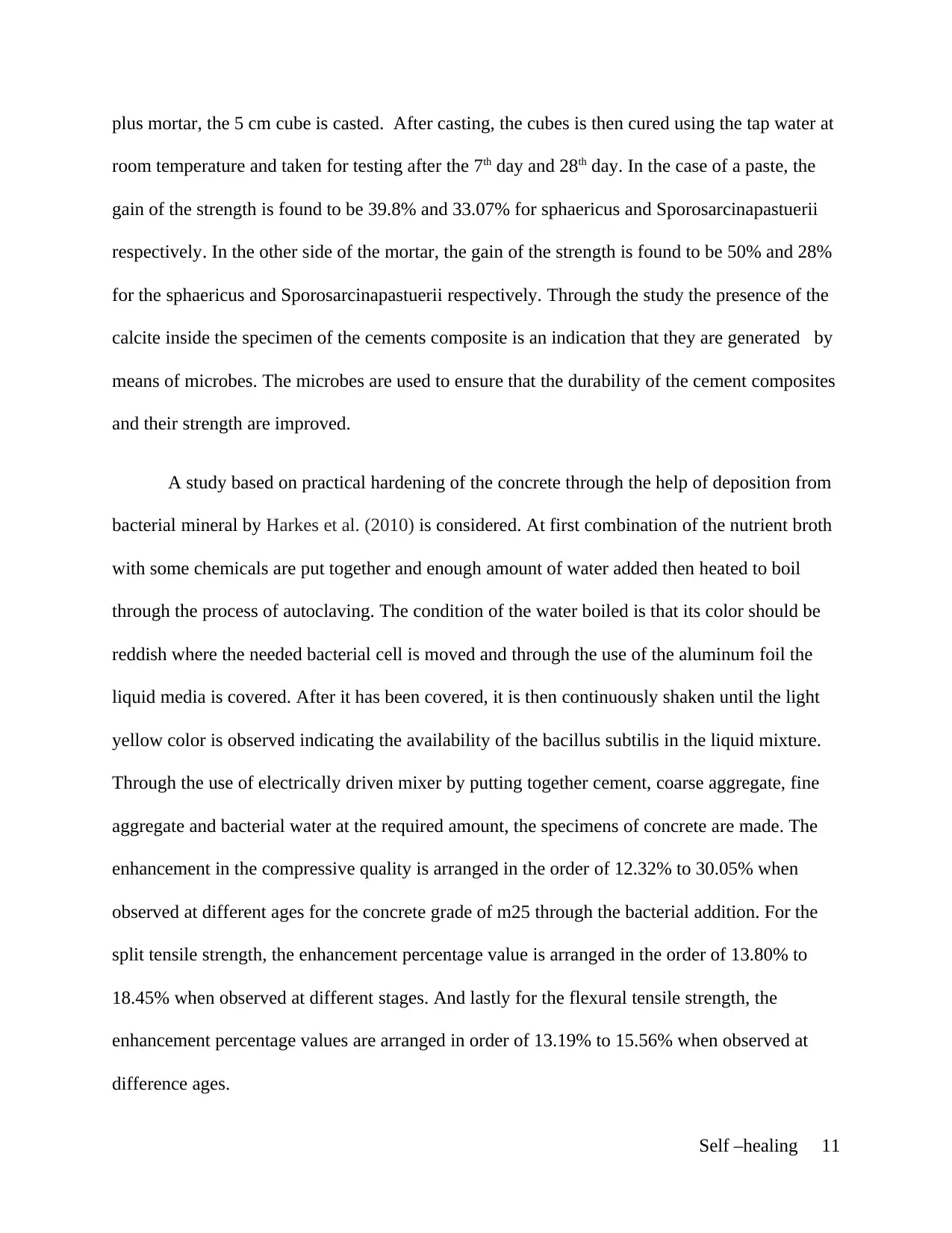
plus mortar, the 5 cm cube is casted. After casting, the cubes is then cured using the tap water at
room temperature and taken for testing after the 7th day and 28th day. In the case of a paste, the
gain of the strength is found to be 39.8% and 33.07% for sphaericus and Sporosarcinapastuerii
respectively. In the other side of the mortar, the gain of the strength is found to be 50% and 28%
for the sphaericus and Sporosarcinapastuerii respectively. Through the study the presence of the
calcite inside the specimen of the cements composite is an indication that they are generated by
means of microbes. The microbes are used to ensure that the durability of the cement composites
and their strength are improved.
A study based on practical hardening of the concrete through the help of deposition from
bacterial mineral by Harkes et al. (2010) is considered. At first combination of the nutrient broth
with some chemicals are put together and enough amount of water added then heated to boil
through the process of autoclaving. The condition of the water boiled is that its color should be
reddish where the needed bacterial cell is moved and through the use of the aluminum foil the
liquid media is covered. After it has been covered, it is then continuously shaken until the light
yellow color is observed indicating the availability of the bacillus subtilis in the liquid mixture.
Through the use of electrically driven mixer by putting together cement, coarse aggregate, fine
aggregate and bacterial water at the required amount, the specimens of concrete are made. The
enhancement in the compressive quality is arranged in the order of 12.32% to 30.05% when
observed at different ages for the concrete grade of m25 through the bacterial addition. For the
split tensile strength, the enhancement percentage value is arranged in the order of 13.80% to
18.45% when observed at different stages. And lastly for the flexural tensile strength, the
enhancement percentage values are arranged in order of 13.19% to 15.56% when observed at
difference ages.
Self –healing 11
room temperature and taken for testing after the 7th day and 28th day. In the case of a paste, the
gain of the strength is found to be 39.8% and 33.07% for sphaericus and Sporosarcinapastuerii
respectively. In the other side of the mortar, the gain of the strength is found to be 50% and 28%
for the sphaericus and Sporosarcinapastuerii respectively. Through the study the presence of the
calcite inside the specimen of the cements composite is an indication that they are generated by
means of microbes. The microbes are used to ensure that the durability of the cement composites
and their strength are improved.
A study based on practical hardening of the concrete through the help of deposition from
bacterial mineral by Harkes et al. (2010) is considered. At first combination of the nutrient broth
with some chemicals are put together and enough amount of water added then heated to boil
through the process of autoclaving. The condition of the water boiled is that its color should be
reddish where the needed bacterial cell is moved and through the use of the aluminum foil the
liquid media is covered. After it has been covered, it is then continuously shaken until the light
yellow color is observed indicating the availability of the bacillus subtilis in the liquid mixture.
Through the use of electrically driven mixer by putting together cement, coarse aggregate, fine
aggregate and bacterial water at the required amount, the specimens of concrete are made. The
enhancement in the compressive quality is arranged in the order of 12.32% to 30.05% when
observed at different ages for the concrete grade of m25 through the bacterial addition. For the
split tensile strength, the enhancement percentage value is arranged in the order of 13.80% to
18.45% when observed at different stages. And lastly for the flexural tensile strength, the
enhancement percentage values are arranged in order of 13.19% to 15.56% when observed at
difference ages.
Self –healing 11
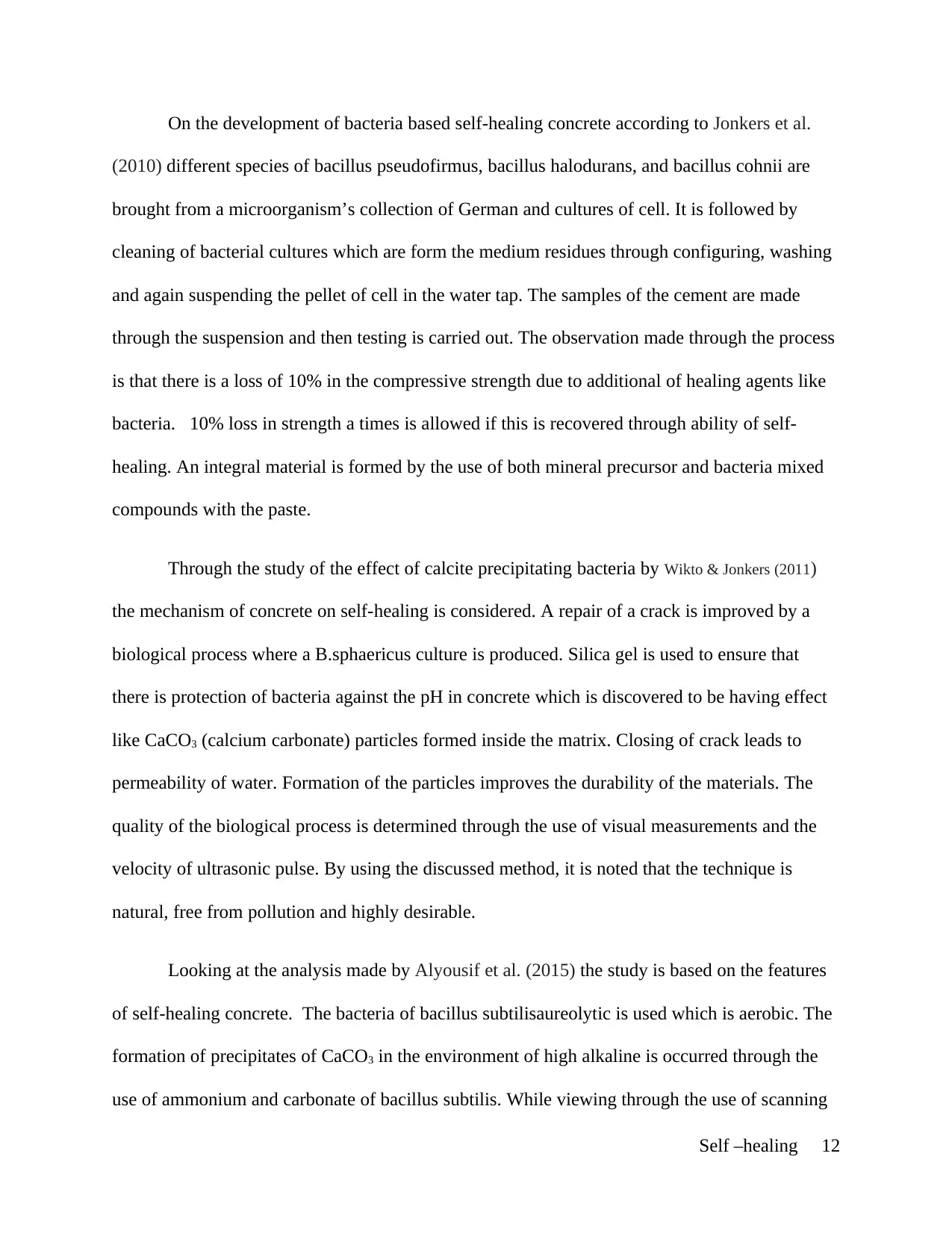
On the development of bacteria based self-healing concrete according to Jonkers et al.
(2010) different species of bacillus pseudofirmus, bacillus halodurans, and bacillus cohnii are
brought from a microorganism’s collection of German and cultures of cell. It is followed by
cleaning of bacterial cultures which are form the medium residues through configuring, washing
and again suspending the pellet of cell in the water tap. The samples of the cement are made
through the suspension and then testing is carried out. The observation made through the process
is that there is a loss of 10% in the compressive strength due to additional of healing agents like
bacteria. 10% loss in strength a times is allowed if this is recovered through ability of self-
healing. An integral material is formed by the use of both mineral precursor and bacteria mixed
compounds with the paste.
Through the study of the effect of calcite precipitating bacteria by Wikto & Jonkers (2011)
the mechanism of concrete on self-healing is considered. A repair of a crack is improved by a
biological process where a B.sphaericus culture is produced. Silica gel is used to ensure that
there is protection of bacteria against the pH in concrete which is discovered to be having effect
like CaCO3 (calcium carbonate) particles formed inside the matrix. Closing of crack leads to
permeability of water. Formation of the particles improves the durability of the materials. The
quality of the biological process is determined through the use of visual measurements and the
velocity of ultrasonic pulse. By using the discussed method, it is noted that the technique is
natural, free from pollution and highly desirable.
Looking at the analysis made by Alyousif et al. (2015) the study is based on the features
of self-healing concrete. The bacteria of bacillus subtilisaureolytic is used which is aerobic. The
formation of precipitates of CaCO3 in the environment of high alkaline is occurred through the
use of ammonium and carbonate of bacillus subtilis. While viewing through the use of scanning
Self –healing 12
(2010) different species of bacillus pseudofirmus, bacillus halodurans, and bacillus cohnii are
brought from a microorganism’s collection of German and cultures of cell. It is followed by
cleaning of bacterial cultures which are form the medium residues through configuring, washing
and again suspending the pellet of cell in the water tap. The samples of the cement are made
through the suspension and then testing is carried out. The observation made through the process
is that there is a loss of 10% in the compressive strength due to additional of healing agents like
bacteria. 10% loss in strength a times is allowed if this is recovered through ability of self-
healing. An integral material is formed by the use of both mineral precursor and bacteria mixed
compounds with the paste.
Through the study of the effect of calcite precipitating bacteria by Wikto & Jonkers (2011)
the mechanism of concrete on self-healing is considered. A repair of a crack is improved by a
biological process where a B.sphaericus culture is produced. Silica gel is used to ensure that
there is protection of bacteria against the pH in concrete which is discovered to be having effect
like CaCO3 (calcium carbonate) particles formed inside the matrix. Closing of crack leads to
permeability of water. Formation of the particles improves the durability of the materials. The
quality of the biological process is determined through the use of visual measurements and the
velocity of ultrasonic pulse. By using the discussed method, it is noted that the technique is
natural, free from pollution and highly desirable.
Looking at the analysis made by Alyousif et al. (2015) the study is based on the features
of self-healing concrete. The bacteria of bacillus subtilisaureolytic is used which is aerobic. The
formation of precipitates of CaCO3 in the environment of high alkaline is occurred through the
use of ammonium and carbonate of bacillus subtilis. While viewing through the use of scanning
Self –healing 12
⊘ This is a preview!⊘
Do you want full access?
Subscribe today to unlock all pages.

Trusted by 1+ million students worldwide
1 out of 39
Your All-in-One AI-Powered Toolkit for Academic Success.
+13062052269
info@desklib.com
Available 24*7 on WhatsApp / Email
![[object Object]](/_next/static/media/star-bottom.7253800d.svg)
Unlock your academic potential
Copyright © 2020–2025 A2Z Services. All Rights Reserved. Developed and managed by ZUCOL.